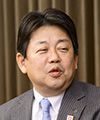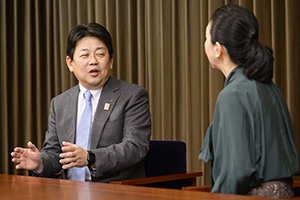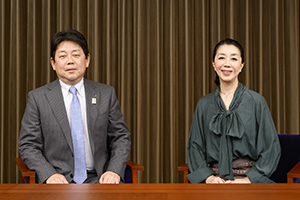 |
|
|
|
|
|
View from the Top Vol. 23, No. 4, pp. 1–6, Apr. 2025. https://doi.org/10.53829/ntr202504tp1
Telecommunications Facilities Are the Nervous System of the Economy—Pursuing Business While Taking a Community-based Approach with a Mindset of Keep ConnectingAbstractNTT WEST is evolving telecommunications to move with the changing times, creating new norms by connecting, and contributing to the creation of a prosperous society. As well as its mission of protecting telecommunications—round the clock, year after year—as a foundation of society, which is something that had been taken for granted, NTT WEST is creating and supporting new products and services that will be taken for granted in daily life and business. We spoke with Kazunori Katsura, senior executive vice president of NTT WEST, about the present situation and outlook for the company’s network-facilities area. Keywords: network facilities, disaster response, APN Leading the Network and Engineering Division with a solid disaster-response system—A year has passed since you were appointed senior executive vice president of NTT WEST. Looking back, how was the past year? When I became senior executive vice president of NTT WEST, we were moving from emergency recovery efforts following the Noto Peninsula Earthquake in January 2024 to full-scale recovery. Since I had been responding to earthquakes as the person in charge of network facilities prior to my appointment, after I became senior executive vice president, I focused on those earthquake recovery efforts with a renewed determination. At that time, the NTT WEST Group had just internally formulated the business plan for fiscal 2024, in which an extremely tough business environment for us was projected, so I felt a great sense of responsibility and was determined to overcome those challenging times. In my present position, I’m mainly in charge of the Network and Engineering Division, and of the approximately 50,000 employees at NTT WEST, about 30%, or about 15,000 people, belong to the network facilities-related departments. Each one has a mindset of “keep connecting,” and they approach their work positively and diligently to keep things running smoothly. As you probably know, in the Noto Peninsula region, heavy rains in September 2024 caused landslides that washed away network facilities being restored after the earthquake; even so, our employees remained motivated and worked hard toward restoration of those facilities.
—You have an impressive team of employees who stays positive in difficult times. Could you tell us about the current situation in NTT WEST’s network-facilities area? When NTT WEST was founded, it focused on providing fixed-line (landline) telephone services. The company’s telecommunications network has mainly consisted of equipment at central offices, such as subscriber exchanges, and metal (copper) cables that deliver telephone services to customers’ homes. We also have owned and maintained the central offices that house these pieces of equipment as well as the cable infrastructure, including underground conduits and utility poles. In the early 1990s, Internet services appeared in Japan, and the emergence of broadband access services, such as ADSL (asymmetric digital subscriber line) and FTTH (fiber to the home), contributed to the popularization of the Internet. In accordance with this change in services from landline telephones to Internet connections, we have developed regional Internet Protocol (IP) networks that make up the Next Generation Network (NGN), which provides optical-fiber access networks and IP telephone services. The demand for optical-fiber access services has run its course, and landline telephone services have transitioned into Hikari Denwa IP telephone services. Accordingly, we have transformed all our relay networks for telephone services from the PSTN (public switched telephone network) to the NGN. The widespread use of mobile phones has led to a decline in the number of landline subscriptions, and in line with this trend, ideally, we want to downsize the amount of metal-cable facilities that we maintain. However, although the transition of landline telephone services to optical-fiber services has plateaued, metal cables continue to be used, which has manifested circumstances in which the concurrent use of metal-cable facilities and optical-fiber facilities is continuing, and the total amount of both facilities is increasing. About 20 years have passed since services using the NGN were first provided; thus, the time to renew various devices is approaching. To address these issues, we must strive to make networks faster, more functional, more economical, and simpler and ensure their continued use. Developing the ability to proactively think and act to solve problems—It seems that both the network facilities and the management are undergoing a major transformation. After consulting with our employees about our future efforts during this period of transition, we established three major pillars: “scaling back legacy services and facilities,” “building facilities to support new challenges for the future,” and “maintaining and strengthening the telecommunications infrastructure as our base.” As the background of these three pillars, I believe that the revision of the Act on Nippon Telegraph and Telephone Corporation, etc. (NTT Act) will be a major turning point. In accordance with the review of universal service obligations under the NTT Act, we will be able to speed up the dismantling of metal-cable facilities by providing inter-prefectural communications via the All-Photonics Network (APN) in a manner that is optimal for the entire NTT Group and by using wireless services. We have also established branches in each of the 30 prefectures where we provide services, and our group company NTT FIELDTECHNO has more than 200 sites for network-facility construction and maintenance, so our strength is that we operate with close ties to local communities. To leverage this strength, we will take this opportunity to once again work on inheriting and updating our on-site capabilities. We intend to pursue these three pillars by taking the following measures. Regarding “scaling back legacy services and facilities,” we will transfer services, such as landline telephones and STM (synchronous transfer mode) dedicated lines, to NGN-based services, and eliminate the metal cables related to those services accordingly. Although we aim to complete the elimination of metal cables over the next ten years (by 2035), since many users still use services via metal cables including six-million landline-telephone subscribers, we expect this transfer to be difficult. Regarding “building facilities to support new challenges for the future,” we aim to (1) further expand our 10-Gbit/s Internet connection service “FLET’S Hikari Cross” and high-speed, large-capacity, highly reliable network service “Interconnected WAN” for businesses; (2) strengthen, upgrade, and simplify the networks that support those services; (3) introduce the APN and other Innovative Optical and Wireless Network (IOWN) technologies and provide services using these technologies; (4) expand our cabling business for datacenter interconnections for hyperscalers; and (5) expand infrastructure business for improving the efficiency of social-infrastructure inspections by using NTT WEST’s assets. We also want to boost all industries as well as our business by taking a community-based approach; therefore, we use the latest technologies, such as IOWN, to create a future network that will help develop various industries in non-metropolitan regions. Visitors to the Expo 2025 Osaka, Kansai, Japan will be able to experience IOWN technology through a service called “All-Photonics Connect powered by IOWN,” which was launched in December 2024. On the basis of the customer feedback received after the provision of the APN IOWN 1.0 service and the results of research and development by the NTT Group, NTT EAST and NTT WEST provides this service to meet market needs for the use of high-speed, large-capacity, and low-latency lines in a wider area while improving customer convenience and creating further use cases. The service supports a maximum bandwidth of 800 Gbit/s, which is the world’s highest level for bandwidth-guaranteed communications between user locations, and supports Ethernet (400GBASE-FR4/LR4, etc.) interfaces. In Japan, aging facilities and a declining workforce are major issues facing the environment surrounding social infrastructure. As a company that supports one of such infrastructures, we will provide our technology for inspecting infrastructure equipment and facilities to other infrastructure companies outside the telecommunications business. With an eye on the global market, we will improve the efficiency of equipment inspections by using drone cameras and expand our business of inspecting road surfaces using a mobile mapping system by harnessing our proprietary artificial intelligent (AI) platform service called “Audin AI.” Regarding “maintaining and strengthening the telecommunications infrastructure as our base,” with an eye toward 100 years of use, we will maintain, manage, and reuse central offices and communications-cable infrastructure (cable tunnels, conduits, and utility poles), which are the foundation for providing a variety of our services. To steadily execute these tasks, we will hone our ability to think and act proactively to solve problems by inheriting and updating our on-site capabilities and use this ability as the driving force behind promoting business operations. To inherit on-site capabilities, we will transfer knowledge to younger generations and hone our technical skills and negotiation abilities.
—Work in the network-facilities area plays an important role, correct? I believe that the telecommunications network we provide is the “nervous system” of the Japanese economy. It is said that Japan’s global competitiveness is declining and its GDP (gross domestic product) ranking is falling, but Japan still has outstanding technologies and engineers. I believe that if these technologies and engineers can use extremely high-quality telecommunications networks, Japan as a whole can grow again, and I want us to do our part in supporting such network utilization. The network facility-related work seen by the general public may be construction of utility poles or installation of optical-fiber lines; however, our work also includes the operation of underground telecommunications networks and central offices. You may have seen on the news inside rail operation centers, but we also centrally monitor the operational status of the nationwide telecommunications network and prepare for breakdowns and other problems; we work behind the scenes, so to speak. Since the infrastructure that supports such a network cannot be completed in a day, we are steadily ensuring uninterrupted communications by using our expertise while facing the difficulty of selecting the right technologies from the medium- to long-term perspective. The area covered by NTT WEST includes many islands, particularly in Okinawa Prefecture, Nagasaki Prefecture, and the Seto Inland Sea, where a variety of industries exist in areas surrounded by the sea. We want to firmly connect these areas to our networks with a mindset of “keep connecting” and support the development of each region by demonstrating its unique characteristics. The history of NTT WEST is one throughout which we have responded to a wide variety of customer requests, and we will continue to take on new challenges proactively and appropriately respond to customers’ requests. Preventing the communication pipeline from clogging—Could you tell us about your journey since joining the company and your mindset as the leader? Since my student days, I have been interested in work concerning infrastructure facilities. Hoping to be able to work on Japan’s nationwide telecommunications infrastructure, I joined NTT in 1992, and in 2025, I entered my 34th year at the NTT Group. I was first assigned to the Yodogawa Branch (at the time) in Osaka, where I was mainly responsible for the maintenance and inspection of communication cables. Since then, I have been involved in capital-investment planning, corporate planning, technology strategy, and network equipment and facilities. Now that I’m senior executive vice president, I’m in charge of overseeing network facilities, and I enjoy my role every day. Naturally, I’m aware of the burden of responsibility that comes with responding to disasters and maintaining sound management. During my third year at the company, when I was working in the Plant Planning Department of the Kansai Branch (as it was then called), the Great Hanshin-Awaji Earthquake occurred, and I experienced a variety of tasks aimed at recovery efforts in an organization close to the scene of the disaster. More recently, when the Noto Peninsula Earthquake occurred in 2024, I led the recovery efforts as executive manager of the Network and Engineering Division. Looking back on these experiences, I feel that no matter what era we are in, we are powerless when faced with a major earthquake or other large-scale disaster. However, I believe it is people, society, and organizations that will overcome these challenges. We can do a lot now, such as applying seismic reinforcement and tsunami countermeasures, developing technologies to support these measures, compiling manuals on how to respond in the event of a disaster, establishing robust organizations, and conducting training. When a disaster strikes, flexible responses that meet the needs of the times are also necessary. I believe it is the leader’s role to decide how to respond to disasters then execute the decisions. On top of that, as a leader, I try to keep calm during crisis management. For instance, a major incident occurred in my third year as an executive: our network experienced a large-scale failure, which inconvenienced many of our customers. At such times, if I, a leader in charge of directing the response, were to get agitated, my staff would be unable to act effectively, so even if I am upset or uneasy inside, I try to remain calm and listen to what the staff has to say and make the right decisions. What one person can do in a job is limited, especially when dealing with disasters and facility failures, which must be confronted not by one person but by a combined team effort. At such times, leaders must listen to what their staff has to say. Since that is not something that only applies in emergencies, I make an effort to listen to the voice of our staff on a day-to-day basis as well. Thankfully, our staff has gained experience in various fields, so they rarely come up with unrealistic ideas. I try to gather their ideas without creating barriers and honestly convey my opinions to them. The senior executive vice president has a different role from the president. The president is responsible for making the final decisions as the manager, while the senior executive vice president applies their area of expertise to complement the knowledge necessary for the president’s decision-making. In reality, the senior executive vice president will be delegated responsibility for certain areas or fields; thus, I see it as my job to approach my delegated areas or fields with the same level of responsibility as the president. Therefore, I try to communicate with the president in an open and honest manner and prevent the communication pipeline between the employees and top management from clogging.
—Finally, could you give us a message to customers, partners, and employees? First, I would like to say a few words to our customers. To repeat myself, I believe that the network-facilities area is the very foundation of Japan’s telecommunications and serves as the nervous system of the economy. We would like to hear any requests that you want to make, and we will respond to them to the best of our ability. We would like you to use our technology and facilities, and let us revitalize Japan together. Next, I would like to say a few words to our partners. In many cases, we are unable to immediately respond to requests, such as those asking to immediately introduce new technology. We will do our best to address these issues, but we appreciate your understanding and cooperation. We hope to grow in unison with our partners and move forward together. Finally, I’d like to say a few words to our employees. I believe that among the corporate groups in the NTT Group, the NTT WEST Group is facing the most difficult business environment. However, up until now, we have taken on new challenges one after another with a variety of ideas. Let us never forget this mindset and continue to grow so that NTT WEST is seen as the most interesting corporate group within the NTT Group—or even among all Japanese companies Interviewee profileCareer highlightsKazunori Katsura joined NTT in 1992. In his career at NTT WEST, he was appointed senior manager of the Planning Section, Network Department, Plant Headquarters in 2012, member of the Board and senior manager of Service Management Department, Plant Headquarters in 2020, and representative member of the Board, executive vice president, and executive manager of the Network and Engineering Division in 2023. He has been in his current position since April 2024. |
|












